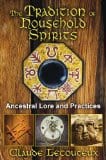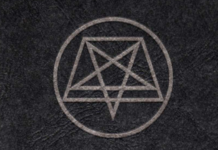
 The Tradition of Household Spirits: Ancestral Lore and Practices, by Claude Lecouteux, translated by Jon E. Graham
The Tradition of Household Spirits: Ancestral Lore and Practices, by Claude Lecouteux, translated by Jon E. Graham
Inner Traditions, 1620551055, 227 pp. (incl. index and eight pages of colour plates), 2013
Ever since his first book, Witches, Werewolves and Fairies: Shapeshifters and Astral Doubles in the Middle Ages in 1992, I’ve quite enjoyed Claude Lecouteux’s work.
Claude Lecouteux is a French historian specialising in the Middle Ages and its understanding of the spiritual world, the chair of German civilization and Literature of the Middle Ages, and a professor emeritus, at the Paris-Sorbonne University.
The Tradition of Household Spirits: Ancestral Lore and Practices was initially published in French in 2000 as La Maison et ses Génies: Croyances d’Hier et d’Aujourd’hui. Personally, I find the French title more apt, since it more clearly describes the content, but that’s a fairly minor quibble on my part. In the original French, this was Lecouteux’s fifth book published. However the English translation are being published in a different order, and this is the seventh book released in English.
The first part of the book begins with the actual house, while the second part of the book turns to the spirits themselves. This is followed by a brief exploration of the notion of haunted houses, and a few appendixes about proverbs associated with household spirits and a few other odds and ends.
In the first part, the sections are arranged, not by culture, but by theme; so we are introduced to the grounds and house construction, the building, its doors and windows, and finally some aspects of its interior. This gives the book a somewhat disjointed feeling, as the author gathers a variety of interesting tidbits about doors and thresholds for example, before moving on to windows and chimneys, etc. It becomes evident that certain parts of the house are more important than others, and certain parts of the house will have more lore than others. However, this became a bit jumbled for me as a reader when one section would draw from six cultures while the next would draw from only three or four cultures, sometimes with little overlap. The lack of coherent commentary on the gathered data also left me somewhat dissatisfied.
The book seems to draw its older information primarily from the classical world and its later examples primarily from transalpine Europe, especially France, Germany, Scandinavia and Eastern Europe. Celtic culture is weakly represented; Scottish lore comes up a few times, as does Brittany and Wales (though these are not always captured by the index), and Ireland does not get mentioned at all. However, for some reason information from Palestine comes up over and over again in the first third of the book and then is never mentioned again. We also have random examples brought in from Chinese and even Inuit cultures. And as mentioned previously, none of the lore given in the first part has any real cultural context.
Honestly, the first half of this book feels like the author’s research notes were simply pulled together and published as-is. Then again, maybe it’s just hard to comment on an inventory of all the parts that make a house, and I’m being hard on the author because I hold him in high regard.
However, even with all of these complaints in mind, the first part also has a few important good qualities. First and foremost, it is an incredible trove of hard to find traditional lore about the house as a spiritual location and a location for spirits, especially from the regions that are the author’s speciality. This information is also fairly well sourced for anyone who wants to follow up on a given bit of information.
In the second and somewhat larger part, Lecouteux regains the coherence and style I’ve come to expect and enjoy from him from his earlier books. Here is where he really shines. The chapters are well laid out, well written, and have both clear conclusions and bridges that bring the reader from one chapter to the next. The author seems to be very thorough in his exploration of household spirits as understood in the Middle Ages in France, Germany, Scandinavia, and Eastern Europe.
Lecouteux explores the roles, origins, and appearance of household spirits; the good and the harm they were thought to be capable of; why they were courted and feared; as well as their connection to the Christian and pre-Christian beliefs of the Medieval period. Likewise, he also collected prayers, charms and other practices that were intended to insure right relations with these spirits so intimate to day to day life.
While the author seems to remain historically accurate and academic about the whole affair, he also says he is recording all of this for posterity so that it will not be lost – a tone that suggests real respect not only for the beliefs but for the objects of these beliefs, the spirits themselves.
Overall, I think this is a very timely book. I’ve been noticing a gradual shift in modern Paganism from focusing on the gods alone, to including the ancestors and spirits of nature; at first in vague and token ways, but increasingly in richer, deeper, and meaningful ways.
This book, while intended as scholarship rather than a practical manual, reminds us that we are embedded in an entire system; that it’s not just us humans and a set of grand but distant deities. Rather we can understand ourselves as existing alongside a wide variety of beings. We can see spirituality as not something that is just ‘out there’, either transcendentally or in the wild, but dwelling intimately with us in the house, and I would add in the village, town, or city. We are changing, and I think a sense of how we can understand the spirits of the home is very compatible with that change, and can help us locate our place in an inspirited world where nothing is without its own energy and nature. The book doesn’t really tell us how we can deepen this aspect of our practice, but it does give us a window on how our ancestors did.
I think this was a very good read, and it now has a special spot on my shelf next to his other works.








